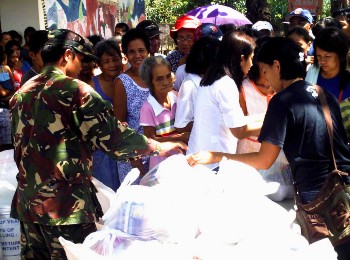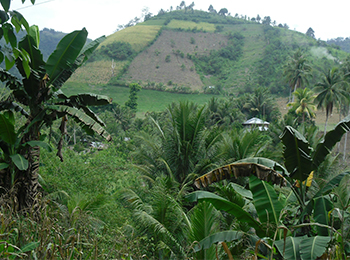About 1 result/s
-
Volume 5, Issue 1, June 2022
With the increasing
incidence of extreme weather events, it is important to identify appropriate
strategies to enhance the adaptive capacity of households. In the Philippines
for example, climate-induced flooding is displacing many people. This is true
in the case of Pila, Laguna, Philippines, which is often flooded when there are
typhoons and monsoon events. Strong typhoons in the past caused houses near the
lake to be submerged in flood waters and forced households to evacuate. The
impact however on these households would vary depending on their adaptive
capacities. This study aims to assess the adaptive capacities of households in
lakeshore communities susceptible to flooding and identify strategies for
policy-makers.

-
Volume 5, Issue 1, March 2022
Bringing aid to disaster-stricken communities is complex, especially in the Philippines where destructive typhoons are intensifying due to climate change. This paper illustrates the coordination for humanitarian aid from Philippine government instrumentalities, the military, uniformed personnel, and civilian sectors as well as from, multilateral organizations and non-government organizations, both local and international during state of national calamities like Typhoon Haiyan. Disaster response increases in complexity in conflict zones such as Bangsamoro Autonomous Region of Muslim Mindanao (BARMM), where armed non-state actors have been active for many years. Encapsulated are the perceptions of 30 respondents coming from government agencies involved in disaster risk reduction and management, including the military and uniformed personnel including humanitarian and relief agencies, during both peacetime and conflict. This embodies challenges in civil-military engagement in balancing mandated tasks such as security, maintaining peace and order, preserving sovereignty, and preventing terrorism with adherence to humanitarian principles and frameworks even while striving to deliver basic humanitarian services in the nexus of climate change and conflict.

-
Volume 4, Issue 1, April 2021
This study assessed the climate trends, changes, impacts, and adaptation strategies of farm households in five barangays in the Roxas mountain range, Koronadal City, South Cotabato by using household survey data from 265 respondents, and complimented with focus group discussions, and key informant interviews. The findings of the study revealed that climate changes are manifested by floods, landslides, and droughts as experienced by the local people which caused devastation and affected socioeconomic and environmental conditions of farming livelihood. Farmers used to have bountiful harvests, however, this situation recently changed due to the increasing climate-related risk events. The existing adaptation strategies are just stop-gap solutions that address the effects of climate change, but do not consider the root causes. To consider future changes in climate patterns, the socioeconomic and political structure and processes of the communities need to change by addressing multifaceted drivers of climate change hazards and their impacts. Some grassroot-level transformative adaptation strategies identified in the study consisted of socioeconomic facets, specifically, investment in children’s education, financial management, family planning, and development of alternative on-farm and nonfarm livelihood options. The environmental aspect, including the promotion of agroforestry system, water impoundment technologies, and advanced early warning system, were also considered.

-
Volume 4, Issue 1, January 2021
The Philippines is one of the countries
highly vulnerable to climate change, and this condition threatens further the meager
agricultural production in the country. However, while the Philippines has
established the institutional foundations linking climate change to agriculture,
through policies and legislation, advances in climate change adaptation have
been slow, especially at the local level. This paper demonstrated that this gap
in policy formulation and actual implementation stems from the lack of institutional
analysis in CCA efforts in the Philippines. The paper concludes that along with
the scientific and technological discussions, institutional conversations
should be among the initial vital steps in CCA planning, and policy and
decision-making. It further advocates that institutional analysis can be the
entry point for designing reforms toward effective CCA implementation.

-
Volume 4, Issue 1, May 2019
Rainwater harvesting
(RWH) is an existing technology proven to be effective in reducing pressure on water
resource, yet often overlooked as a viable alternative for supplying water to
households and businesses while reducing stormwater runoff in urban settings. This
paper developed, fabricated and tested various collapsible rubber tank (CRT)
designs and influence water users and decision-makers to strongly support RWH. With
proper handling and maintenance, CRT can be a good alternative for rainwater
storage and can be used in hard-to-reach areas particularly during emergency
situations and relief operations.

-
Volume 3, Issue 1, August 2018
In 2013, Super Typhoon Haiyan, one of the strongest tropical
cyclones to impact the Philippines, made landfall in Tacloban City. The typhoon
incapacitated the city, breaking down its main lifeline, the transport system.
This article analyzes how a weakened transport system exacerbates disaster
vulnerability, specifically manifested in the restricted mobility and access of
people and communities immediately after an extreme event.
-
Volume 3, Issue 1, August 2018
Typhoon Pablo (Bopha) was the most powerful storm to have hit the island of Mindanao, southern Philippines in more than 100 years of recorded storms. This paper identified the adaptation gaps in the post-Typhoon Bopha recovery and reconstruction based on roundtable discussion, household survey and conjoint analysis.
-
Volume 2, Issue 2, July 2017
The livelihoods of Aytas of Floridablanca, Pampanga, Philippines are dependent on natural resources, which are prone to climate change impacts. To assess their adaptive capacity, this paper analyzed the different resources available in their community using the Sustainable Livelihoods Approach Framework.
-
Volume 2, Issue 2, July 2017
In many small island developing states (SIDS), tourism is a principal driver of the economy and of infrastructure development. The SIDS’ tourism sector is, however, threatened by climate change impacts, which will likely incur high costs for climate change adaptation (CCA).
-
Volume 2, Issue 2, July 2017
The very real threat of climate change requires effective disaster risk management (DRM), especially in highly vulnerable ecosystems such as island communities. Past disaster experiences in different parts of the world have revealed the importance of integrating traditional ecological knowledge (TEK) with scientific fndings in managing disaster risk.